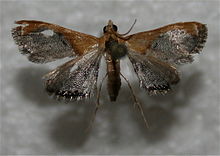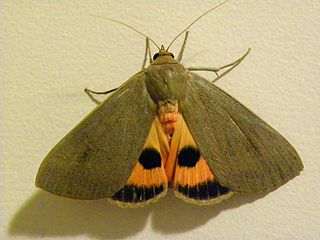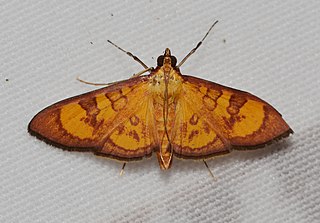| Chalcoela | |
|---|---|
 | |
| Chalcoela iphitalis | |
| Scientific classification | |
| Kingdom: | |
| Phylum: | |
| Class: | |
| Order: | |
| Family: | |
| Genus: | Chalcoela |
| Chalcoela | |
|---|---|
 | |
| Chalcoela iphitalis | |
| Scientific classification | |
| Kingdom: | |
| Phylum: | |
| Class: | |
| Order: | |
| Family: | |
| Genus: | Chalcoela |

The Pyralini are a tribe of snout moths described by Pierre André Latreille in 1809. They belong to the subfamily Pyralinae, which contains the "typical" snout moths of the Old World and some other regions. The genus list presented here is provisional.

Hypena is a genus of moths in the family Erebidae. It was first described by Franz von Paula Schrank in 1802. These non-migratory moths overwinter as pupae and almost never estivate as adults.

Omiodes is a moth genus in the family Crambidae. Several species are endemic to Hawaii.

Pycnarmon is a genus of moths of the family Crambidae described by Julius Lederer in 1863.

Parapoynx is a genus of moths of the family Crambidae described by Jacob Hübner in 1825.

Patania is a genus of moths of the family Crambidae described by Frederic Moore in 1888.

Phostria is a genus of moths of the family Crambidae.

Prenesta is a genus of moths in the family Crambidae. The type species is Prenesta fabialis.

Samea is a genus of moths of the family Crambidae described by Achille Guenée in 1854.

Elusa is a genus of moths of the family Noctuidae erected by Francis Walker in 1859.

Chalcoela iphitalis, the sooty-winged chalcoela, is a moth species of the family Crambidae that occurs throughout North America. They are seen as far south as California, Arizona and South Carolina and as far north as Ontario. Adults can be seen from May to August. The head, body and front portion of the forewings are yellow-orange while the hindwing and back portion of the forewings are grey and silver. The back edge of the hindwing has black spots.

Desmia is a genus of moths of the family Crambidae. The genus was erected by John O. Westwood in 1832.

The Chrysauginae are a subfamily of snout moths. They are primarily Neotropical and include about 400 described species.

Gesonia obeditalis is a species of moth of the family Noctuidae first described by Francis Walker in 1859. It is found from eastern Africa, the Seychelles, the Maldives and the Oriental tropics of India, Myanmar, Sri Lanka east to the Philippines, the Sula Islands and Australia. The adult moth has brown wings with a scalloped dark brown band near the margin. The hindwings are similar in pattern to the forewings but are a paler shade of brown.

Polistes exclamans, the Guinea paper wasp, is a social wasp and is part of the family Vespidae of the order Hymenoptera. It has been found in Ontario, Canada and the eastern United States from Illinois down south to Florida and west to Nebraska and California. It is also found in Mexico from Chihuahua to Jalisco, Hidalgo. P. exclamans has shown variability in its range including an absence of the species in eastern Missouri from the 1920’s to 1940’s, a presence in the 1960’s to 1980’s, and an apparent absence again of the species in these same sites in eastern Missouri since 1989. This suggests that their range has either expanded northward and contracted southward or that they have large, long-term cycles of abundance. P. exclamans has three specific castes, including males, workers, and queens, but the dominance hierarchy is further distinguished by age. The older the wasp is, the higher it is in ranking within the colony. In most P. exclamans nests, there is one queen who lays all the eggs in the colony. The physiological similarities between the worker and queen castes have led to experiments attempting to distinguish the characteristics of these two castes and how they are determined, though males have easily identifiable physiological characteristics. Since P. exclamans live in relatively small, open combed nests, they are often subject to predators and parasites, such as Chalcoela iphitalis, Elasmus polistis, and birds. P. exclamans have defense and recognition strategies that help protect against these predators and parasites.

Glaphyriinae is a subfamily of the lepidopteran family Crambidae. It was described by William Trowbridge Merrifield Forbes in 1923. The subfamily currently comprises 509 species in 75 genera.

Chalcoela pegasalis, the wasp parasitizer moth, is a moth in the family Crambidae. It was described by Francis Walker in 1859. It is found in Cuba, Jamaica, the French Antilles, Puerto Rico and also the United States and Canada.

Margaroniini is a tribe of the species-rich subfamily Spilomelinae in the pyraloid moth family Crambidae. The tribe was erected by Charles Swinhoe and Everard Charles Cotes in 1889, originally as family Margaronidae.